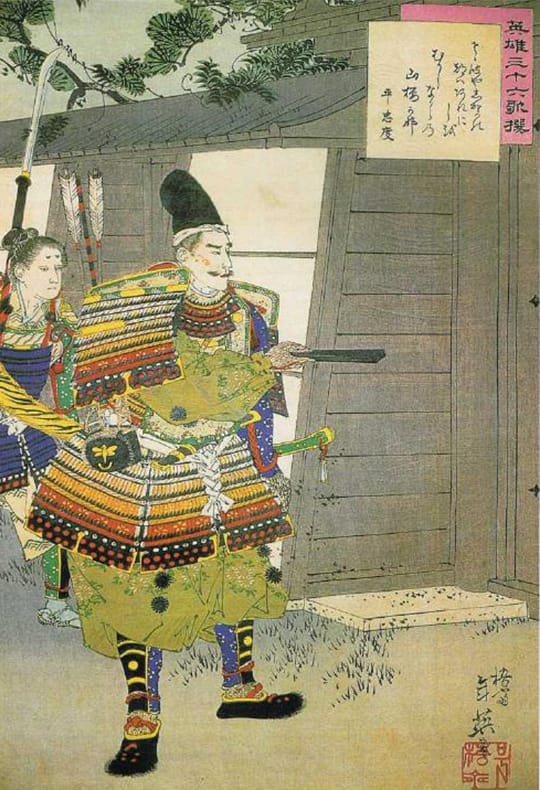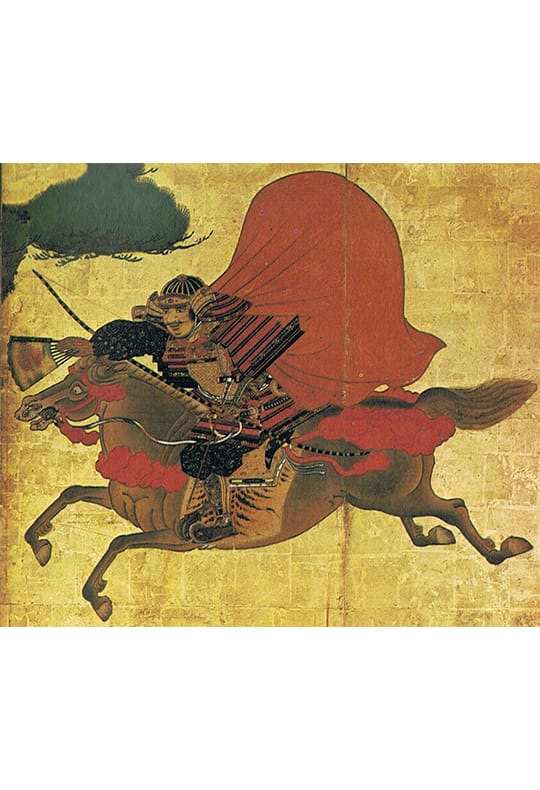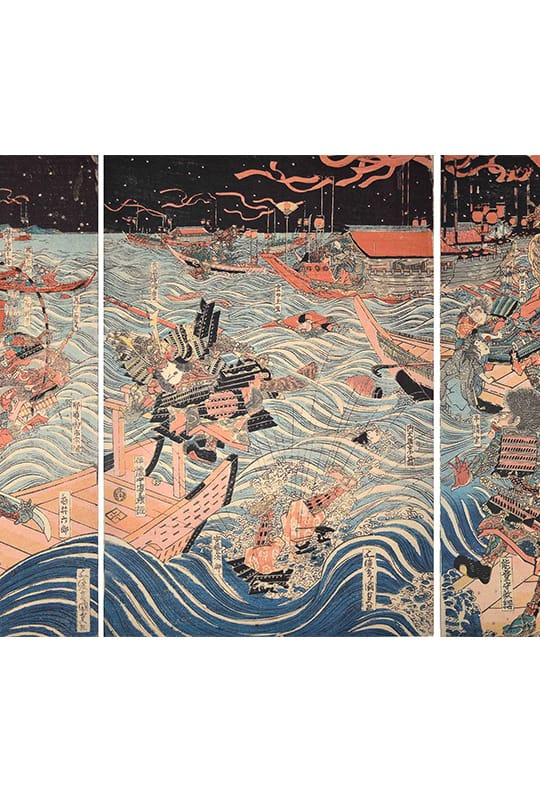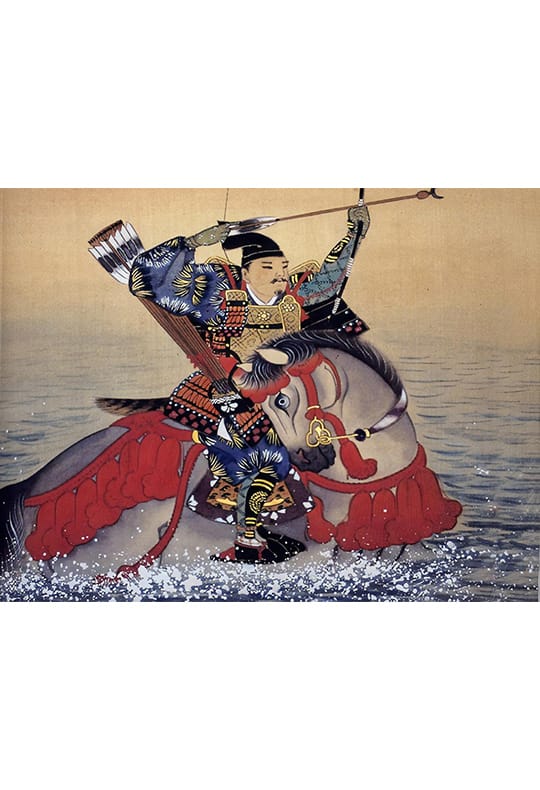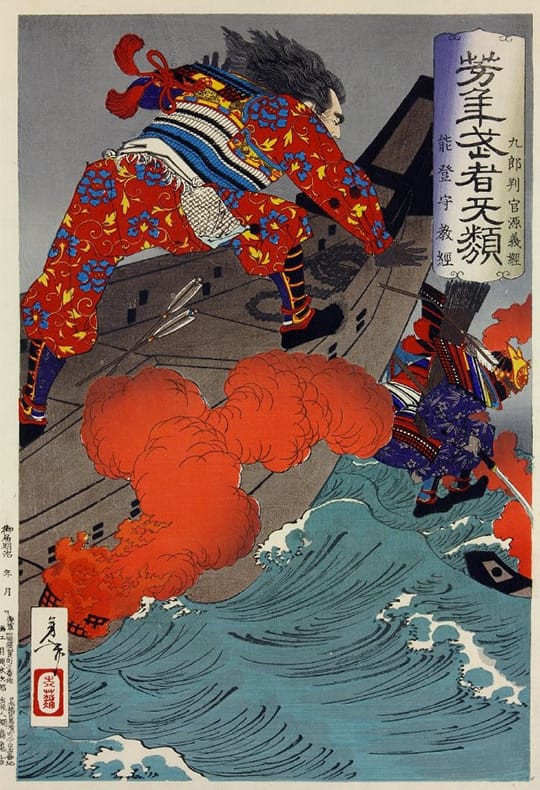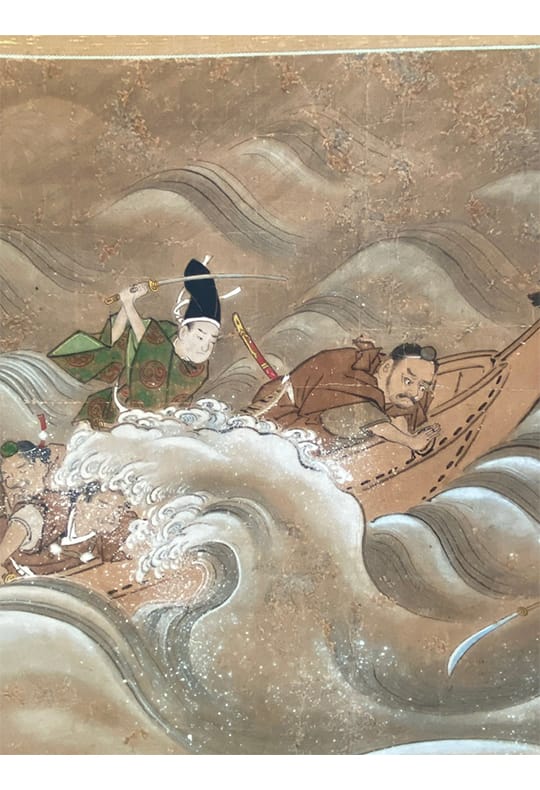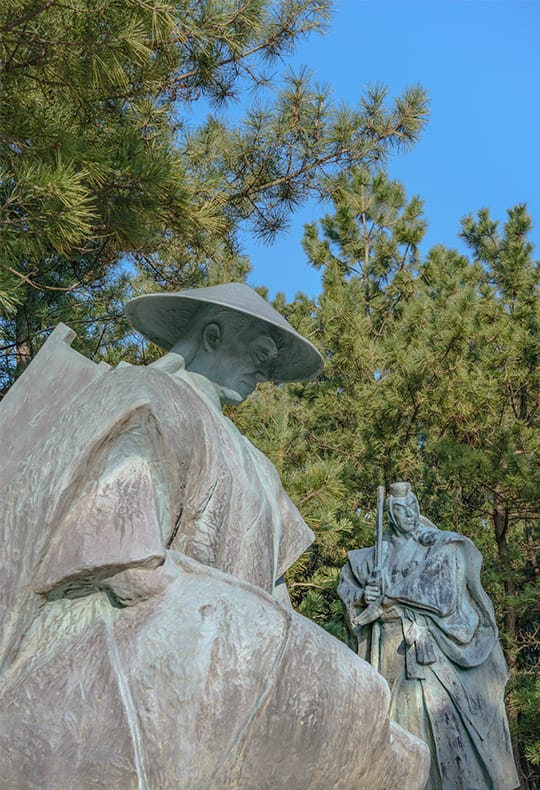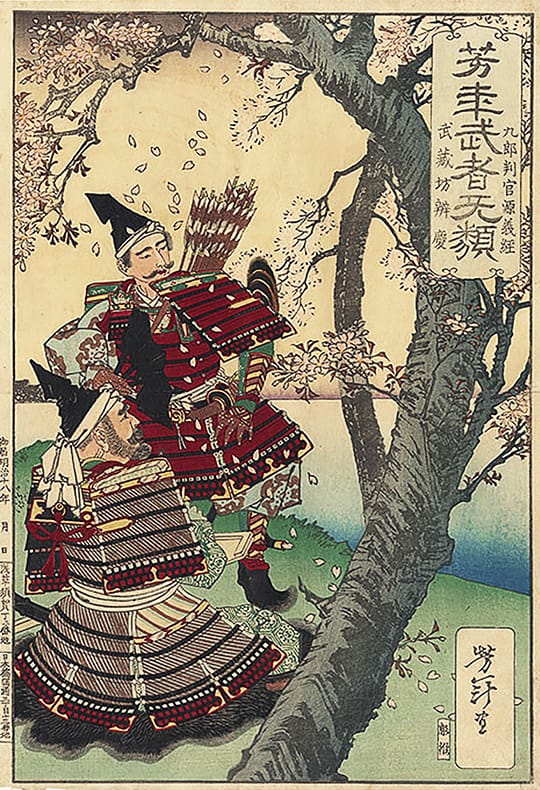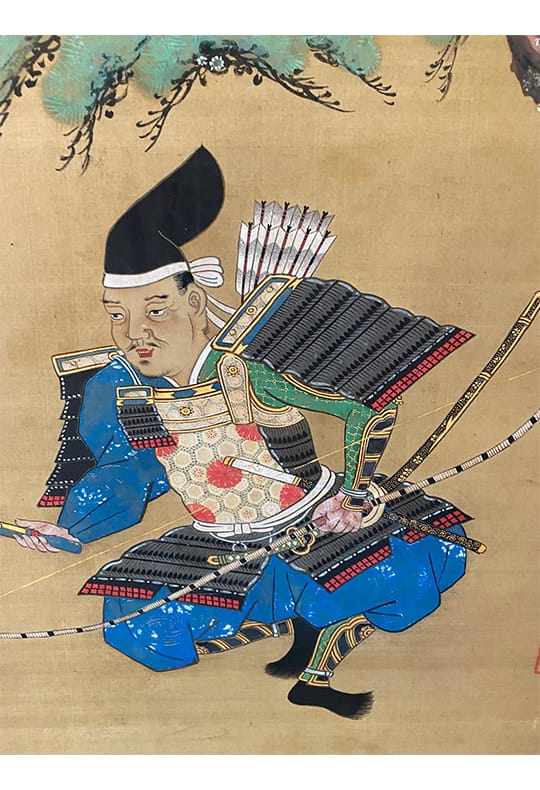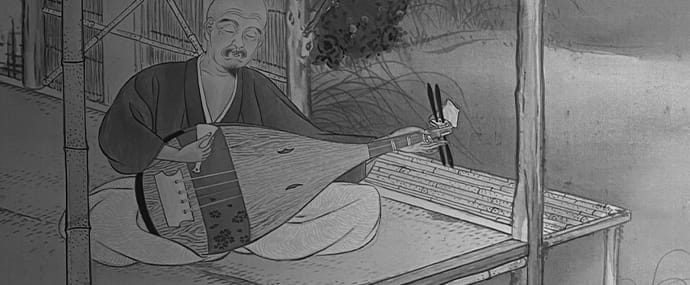The Tale of the Heike-search

dan no ura hikyoku
壇の浦 悲曲
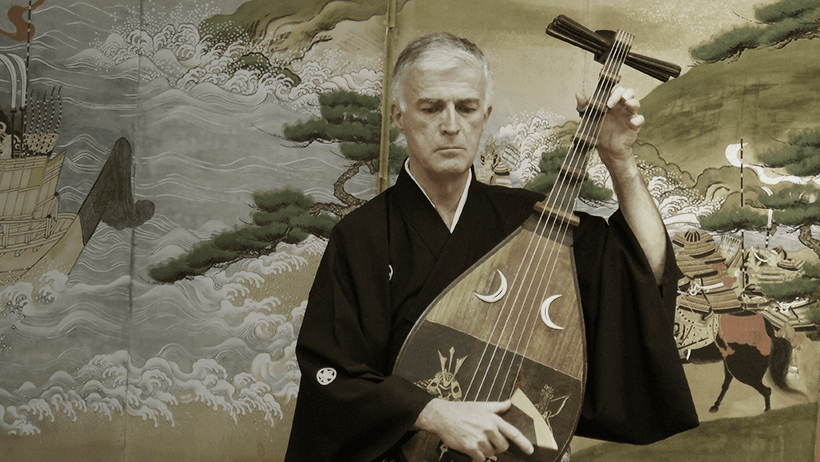
Introduction
The battle of Dannoura marks the end of the Heian period (794-1185), a remarkable era of art and culture that emerged from the imperial court in Kyoto. For centuries, the HEIKE (TAIRA) clan had managed to acquire an extremely influential position in the court through marriage and other strategies. Their rise in political power, however, was accompanied by abuse, and was challenged by the GENJI (MINAMOTO) clan, who finally destroyed them through numerous battles at the end of the 12th century. With the battle of Dannoura in 1185 in western Japan, the HEIKE were completely defeated. This battle changed Japanese history and culture on a fundamental level, and the epic story of their demise is found in all literary genres — poems, ballads, Noh, Kabuki, Bunraku, and more — from the following centuries.
This poetic song-piece is a short and compact version of the much larger chikuzen biwa ballad, Dannoura (see also introduction to Dannoura), and complements it by depicting the most moving moment from the final stages of the battle: the death of the child emperor Antoku.
Synopsis
Dannoura is the name of a strait close to present-day Shimonoseki, Yamaguchi Prefecture, where the last battle, a battle at sea, between the HEIKE and the GENJI occurred in 1185. At an early stage of the fight, the Commander-in-Chief of the HEIKE, Tomomori, realized that the HEIKE would be defeated. He moved to the Imperial Boat to inform the court ladies attending the child emperor Antoku of their grave situation. Nii no Tsubone, caring for her grandchild, the emperor, decided to drown with the emperor rather than falling into enemy hands. When she takes him in her arms, emperor Antoku becomes anxious, and asks where she will take him. She answers that she will accompany him to the Pure Land. To bid farewell, he bows to the East, the direction of the Grand Ise Shrine, and then, facing West, where the Buddhist Paradise lies, folds his hands in prayer. To convince him to go with her, Nii no Tsubone tells the emperor that there is another capital at the bottom of the sea. She then jumps over board with him and with two of the Three Sacred Treasures: the Sword and the Jewel.

Lyrics
-
1. And so, after their defeat at the battle of Yashima Nun denn: seit der Niederlage in der Schlacht von Yashima
Saru hodo ni Yashima no ikusa ni uchiyabure さる程に屋島の戦に打破れ
-
2. the HEIKE were relentlessly pursued. hörte für die HEIKE-Sippe das Verfolgtsein nicht mehr auf.
oware owareshi HEIKE no ichimon 追はれ追はれし平家の一門
-
3. They directed their boats towards the West Sie nahmen auf den Schiffen Kurs nach Westen,
funaji kasanete saigoku wa 船路重ねて西国は
-
4. and fled to the bay of Dannoura in Nagato. flohen bis nach Nagato zur Bucht von Dannoura.
Nagato Dannoura ni zo ochinikeri 長門壇の浦にぞ落にけり
-
5. In the third month of the first year of the Bunji era (1185), Seit dem Lenzmonat des ersten Jahres in der Bunji Ära (1185)
toki wa Bunji gannen Yayoi no koro 時は文治元年弥生の頃
-
6. the GENJI, continuing their unyielding pursuit. setzte die Armee der GENJI ihnen wieder unablässig zu.
GENJI wa sarani tsuitō no te o yurumezu 源氏はさらに追討の手をゆるめず
-
7. positioned their ships, and launched their attacks. Sie brachten ihre Schiffe gut in Stellung, griffen unverzüglich an.
fune o shitatete semekereba 船を仕立てゝ攻めければ
-
8. In Dannoura, where the currents are strong, Hier in der Bucht von Dannoura, kraft der starken Strömung,
kaichō tagiru Dannoura ni 海潮たぎる壇の浦に
-
9. the GENJI and the HEIKE cut through the waves teilten alle GENJI-Schiffe und auch jene von den HEIKE hohe Wellen
nami o ketatete GENPEI no 波をけたてゝ源平の
-
10. in their final spectacular battle. in der letzten wilden Schlacht.
saigo no ikusa hanabanashi 最後のいくさ華々し
-
11. Here was the leader of the HEIKE, Da seht den HEIKE-General,
koko ni HEIKE no sōsui こゝに平家の総帥
-
12. Lord Tomomori, a vice-counselor Fürst Tomomori, der die Stellung eines Vize-Rats bekleidet.
Shinchūnagon Tomomori-kyō wa 新中納言知盛卿は
-
13. and warrior of incomparable bravery. Stark und mutig wie kein andrer Krieger war er,
yūsō muhi no tsuwamono naredo 勇壮無比の武将なれど
-
14. For his large army, the situation was grim. doch für seine große Streitmacht war die Lage aussichtslos,
tenka no ikioi Heike ni ri arazu 天下の勢平家に利あらず
-
15. There was naught they could do with their imminent defeat. die Niederlage war nicht abzuwenden.
haishoku koki o ika ni sen 敗色濃きを如何にせん
-
16. “This is as far as we shall go, Wie er einsah, dass der letzte Augenblick gekommen war,
ima wa kore made to omoikime 今はこれまでと思いきめ
-
17. and so I wish to move to the ship da wollte er zum Kaiserschiff hinüberwechseln.
shujō no imasu gozasen ni 主上のいます御座船に
-
18. where the Emperor is.” he said. Und so sprach er:
noriutsurite zo mōsarekeru 乗り移りてぞ申されける
-
19. “Our battle has come to its end, „Unsere Kämpfe gehen hier zu Ende,
yannuru kanaya kono ikusa 止んぬるかなや此のいくさ
-
20. and though the HEIKE clan will perish here, sicher wird die ganze HEIKE-Sippe untergehen.
koko nite Hei ichimon ga horobu tomo こゝにて平家一門が滅ぶとも
-
21. something to regret, but I see no other way.” Traurig ist das, doch ich sehe keinen Ausweg.”
munen naredomo sen mo nashi to 無念なれ共せんもなしと
-
22. And with these final words Diese Worte waren seine letzten.
saigo no kotoba notamaeba 最後の言葉のたまえば
-
23. the court lady, Nii no Tsubone HEI no Tokiko, Nii no Tsubone, die hohe Dame, HEI no Tokiko,
HEI no Tokiko Nii no Tsubone wa kanete yori 平の時子二位の局は兼てより
-
24. her face calm with resignation, fasste sich, ihr Antlitz strahlte Ruhe aus.
kakugo no omote shizuka nite 覚悟の面静かにて
-
25. attired in a two-layered dark gray kimono, Gekleidet in zwei dunkelgraue Kimonos,
nibu iro no futatsuginu uchikatsugi にぶ色の二衣うちかつぎ
-
26. seized the Three Sacred Treasures. nahm sie die Drei Kaiserschätze an sich .
sanshu no shingi o mi ni tsukete 三種の神器を身につけて
-
27. She carried the young emperor, Antoku Danach hob sie Antoku, den Knabenkaiser,
osanaki shujō Antoku-tei o 幼き主上安徳帝を
-
28. in her left arm, auf den linken Arm
hidari katate ni idaki mairase 左片手にいだき参らせ
-
29. and turned herself toward Lord Tomomori. und wandte sich zum Fürsten Tomomori.
Tomomori-kyō o furikaerite 知盛卿を振り返りて
-
30. “Though a mere woman, it is improper for me „Eine Frau bin ich zwar nur, doch geht es jetzt nicht an,
waga mi wa nyonin naredomo imasara ni 我が身は女人なれども今更に
-
31. to fall into the hands of the enemy.” dass ich in Feindeshände falle.
teki no te ni wa kakaru maji 敵の手にはかゝるまじ
-
32. It is my intention to accompany the Emperor.” Lasst mich also für den Kaiser die Begleitung sein.”
ideya kimi no ontomo tsukamatsuran to いでや君の御供仕らんと
-
33. And she bade farewell to this world. Mit diesen Worten nahm sie Abschied von der Welt.
kono yo no wakare o mōsaretari この世の別れを申されたり
-
34. At this time Emperor Antoku Der Kaiser Antoku war damals
kono toki Antoku Tennō wa この時安徳天皇は
-
35. was only noch im zarten Alter
ontoshi wazuka hassai ni zo 御年僅か八才にぞ
-
36. eight years old. von acht Jahren.
narase tamaishi ga ならせ給ひしが
-
37. Anxiety beset his young heart Angst befiel sein Kinderherzen.
osanaki kokoro ni fushin o idakare 幼き心に不審を抱かれ
-
38. “Grandmother, where do you plan „Wohin denn, Großmutter,
ama yo ware o ba izukata e 尼よわれをばいづ方へ
-
39. to take me now?” he asked. wollt Ihr mich bringen?“ fragte er.
tsure yukan to suru zo to toitamau 連れ行かんとするぞと問い給う
-
40. Nii no Tsubone looked into the heavenly face, Nii no Tsubone betrachtete das himmlische Gesicht
Nii no Tsubone wa ryōgan o haishi 二位の局は竜顔を拝し
-
41. and could not hold back her tears. und konnte ihre Tränen nicht mehr halten.
nanda shitodo ni musebitsutsu 涙しとゞに咽びつゝ
-
42. “You were born an Emperor, “Kaiser seid Ihr,
kimi wa ima banjō no shu to 君は今の万乗の主と
-
43. but nevertheless, hoch geboren,
umaresase tamae domo 生れさせ給へども
-
44. a bad karma doch ein schlechtes Karma,
akuen ni hikarete 悪縁にひかれて
-
45. has already determined your fate. lenkt nun Euer Schicksal.
goun sude ni tsukisase tamainu 御運すでに尽きさせ給ひぬ
-
46. I will now accompany you to the Pure Land”, Ich will Euch ins Paradies des Reinen Landes führen“,
ima gokuraku jōdo ni tsure mairase saburō to 今極楽浄土につれ参らせ候と
-
47. she choked through her tears. brachte sie hervor, von Tränen fast erstickt.
nakunaku mōshiagekereba 泣く泣く申上げければ
-
48. The Emperor wore a dove-gray garment, Der Kaiser trug ein taubengrau Gewand
mikado wa yamabatoiro no onzo ni 帝は山鳩色の御衣に
-
49. his hair youthfully gathered at the sides of his head, und hatte seine Haare aufgesteckt im Knabenstil der Zeit.
binzura gami o iwase tamaite びんづら髪を結はせ給いて
-
50. His eyes were filled with tears white like the haze of waves. In seinen schönen Augen glänzten Perlentränen.
karenna hitomi ni shiroki nami no tsuyu yadoshi 可憐な瞳に白き波の露やどし
-
51. As he followed Nii no Tsubone’s directions, Nii no Tsubone hieß ihn
Nii no Tsubone no iu mama ni 二位の局のいふまゝに
-
52. he pressed together hands his lovely as maple leaves, seine Hände falten, die so schön wie Ahornblätter waren
momiji no te o ba awase tamai 紅葉の手をば合せ給い
-
53. and paid reverence to the skies of the east. und den Blick nach Osten himmelwärts zu richten.
higashi no sora o ogamarete 東の空を拝まれて
-
54. He then turned to the West and chanted to the Buddha. Dann gebot sie ihm, im Westen Buddha anzurufen.
nishi ni mukaite gonenbutsu ageshikaba 西に向いて御念仏あげしかば
-
55. “Time passes,” thought Nii no Tsubone, and to the emperor she said, „Doch nun drängt die Zeit“, sprach Nii no Tsubone zu sich.
toki okurete wa to Nii no Tsubone 時遅れてはと二位の局
-
56. “Beneath these waves, another Capital awaits!” „Vertraut‘ mir, unter diesen Wellen gibt es eine Kaiserstadt!“
nami no shita ni mo miyako no arite saburō zo to 波の下にも都のありて候ぞと
-
57. From the railing Vom Schiffsrand in die Wogen
hatō megakete funaberi yori 波涛めがけて船辺より
-
58. she leapt with the Emperor stürzte sie sich mit dem Kaiser
shujō morotomo mi o odorase 主上諸共身をおどらせ
-
59. to sink a thousand fathoms to the bottom of the sea. tausend Klafter in die Tiefe auf den Meeresgrund.
chihiro no soko e zo shizumase tamō 千尋の底へぞ沈ませ給ふ
-
60. How sad, Ach wie traurig ist das!
aa kanashiki ka na あゝ悲しきかな
-
61. the transient spring breeze, wie ein Frühlingswind – so unbeständig, ohne Halt.
mujō no haru no kaze 無常の春の風
-
62. and how merciless are So unbarmherzig
nasake naki kana 情なきかな
-
63. the surging waves of this corrupt world. ist die Welt mit ihren wilden Wellen,
shaba sekai no araki nami 娑婆世界の荒き波
-
64. The youthful imperial jewel die das Kleinod
on’itokenaki gyokutai o 御いとけなき玉体を
-
65. sank beneath the waves. in die Tiefe sinken lassen.
nami no shita ni zo shizume tatematsuru 波の下にぞ沈め奉る
-
66. Once they ruled with the right of heaven, Fest in ihren Händen war einmal die Macht auf dieser Erde.
tenka no ken wa waga ga shuchū to 天下の権は我が手中と
-
67. but now their glory has passed. Während Jahren hatte ihre Pracht gestrahlt
sugishi eiga no toshitsuki o 過ぎし栄華の年月を
-
68. These flowers that once bloomed in the lanes of the Capital, wie all die Blütenbäume in der Hauptstadt.
miyako ōji ni saku hana no 都大路に咲く花の
-
69. the HEIKE, vanished in Dannoura Doch in Dannoura ging die HEIKE-Sippe unter,
HEIKE no ichimon Dannoura ni 平家の一門壇の浦に
-
70. without a trace. ohne eine Spur zu hinterlassen –
chirihorobi hatete ato mo nashi 散り滅び果て跡もなし
-
71. In the desolate wind of sorrow. übers Wasser streicht ein Trauerwind verlassen.
ima shōshō no kaze aware 今蕭々の風哀れ
-
72. the proud HEIKE did not last, Kurz nur dauerte der Stolz der HEIKE –
ogoru HEIKE wa hisashikarazu 奢る平家は久しからず
-
73. no more than the dream of a spring night nur so lange wie ein Traum in einer Frühlingsnacht,
tada haru no yo no yume no gotoshi ただ春の夜の夢の如し
-
74. no more than the dream of a spring night. ein Traum in einer Frühlingsnacht.
tada haru no yo no yume no gotoshi ただ春の夜の夢の如し
Notes
1. The Battle of Yashima… (See notes for Yashima for further details.) This battle on the island of Shikoku in 1185 was one of the last great encounters between the HEIKE and the GENJI armies, which finally brought the 400-year Heian period (794-1185) to its end. 4. Dannoura in Nagato… A strait close to the present-day city of Shimonoseki in Yamaguchi Prefecture (see detailed notes for Dannoura) 12. Lord Tomomori… TAIRA no Tomomori (1152-1185) was the fourth son of the HEIKE leader TAIRA no Kiyomori. 23. Lady Nii no Tsubone… was the wife of the late TAIRA no Kiyomori. She was also the mother of Kenreimon’in and the grandmother of Emperor Antoku. 25. Dark grey kimono… The mouse-grey color of the kimono shows that the lady has become a nun. 26. The Three Sacred Treasures… These treasures are the mirror, the sword and the sacred jewel. The HEIKE carried these items with them as symbols of the imperial presence of the child emperor, Antoku, whom they had accompanied since leaving the capital, Kyoto. 34. Emperor Antoku…Born in 1178; he was the 81st emperor. By Western count, he was 7 years old when he drowned in Dannoura. He was named crown prince when two months old, and became emperor at the age of two. Due to his young age, however, the head of the HEIKE clan, TAIRA no Kiyomori, served as regent. 49. The hair gathered… On both sides of his head, the hair was bundled into gourd-shaped knots, a normal style for boys since antiquity. 52. Maple leaf shaped hands…When children fold their hands, they do not align their fingers, but spread them out so that they resemble maple leaves. This detail may contribute to the emotional impact of the scene. 53. A reverence to the East… This reverence is made toward the holiest of all shintō shrines, the Imperial Family Shrine of Ise. 54. Turn to the West… In the West is the Buddhist Paradise, The Pure Land. 73. No more than the dream of a spring night… This line is a citation from the beginning of the Tales of the Heike, in which the essence of the entire tale is presented.

Music Notes
The musical qualities of YAMAZAKI Kyokusui’s composition, Dannoura Hikyoku, are considerably more lyric than narrative, despite their focus on the battle report of Dannoura. The melodies are more intricate, and seldom follow the standardized melodic patterns of the older pieces of the chikuzen biwa repertoire. Nowadays, some performers attempt a composite of Dannoura and Dannoura Hikyoku. In most instances, they begin with the opening of Dannoura through line 55 — with omissions depending on the time limits of the performance — and then shift to Dannoura Hikyoku starting from line 11. In addition to the truncated plot, many people find the balance of lyric and narrative is considerably improved. Dannoura Hikyoku was composed for an artist with talents matching those of ITAYA Kyokuyū, an outstanding performer endowed with a very high voice. YAMAZAKI Kyokusui, whose voice was rather low, had difficulties in performing her own composition with the musical details she had included.
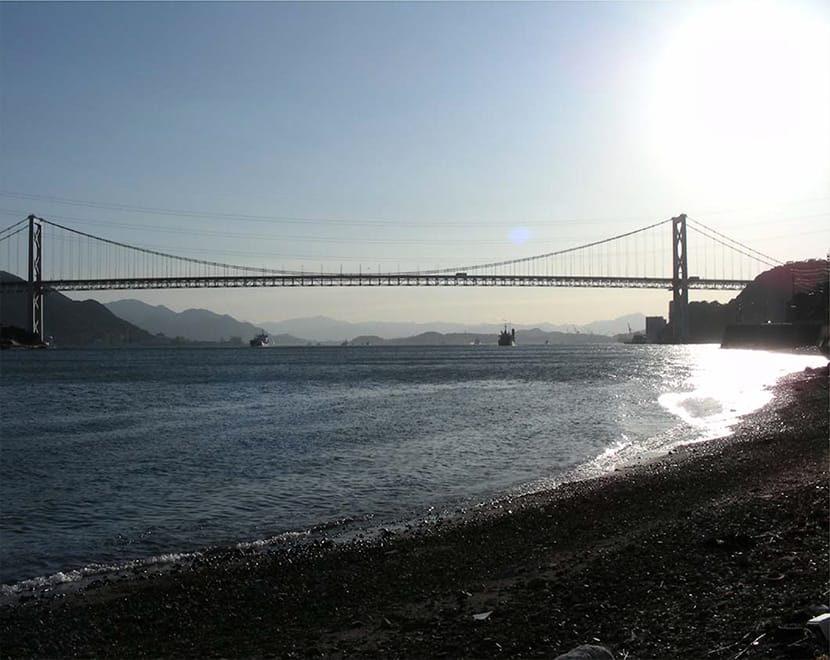
One of the many compositional novelties in this piece that should be introduced is a unique interlude. In chikuzen biwa, the most important distinction between interludes is “poetic expression” versus “dramatic expression”. Most of the interludes that fall into the poetic category are named after flowers. Those flowers with inherent philosophical or religious implications are naturally treated with greater care in their musical settings. The flower most imbued with philosophical implications in Japan is sakura, or the cherry blossom, and the Sakura interlude is accordingly long and beautifully crafted, which, perhaps due to its depth of meaning, is never played in its entirety. It is normally used when lamenting a hero’s death.
After the tenth line of this piece, “in their final spectacular battle”, the middle section of the Sakura interlude is performed, and is meant to illustrate the final battle, despite the wide choice of dramatic interludes available. YAMAZAKI Kyokusui, however, chose the poetic Sakura interlude, which presents a considerable challenge to the performer. To impart a convincing sense of drama to this interlude used for the depiction of a battle at sea, the performer must exploit the full range of technique, vigorously and aggressively accenting beats to create the necessary musical effect.
What did the composer gain with this choice? The Sakura interlude at this particular point imparts a deep sense of melancholy, as the educated listener is deeply aware that this spectacular battle leads unavoidably to the defeat of the HEIKE, just as the cherry blossom loses its petals.
